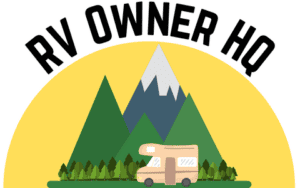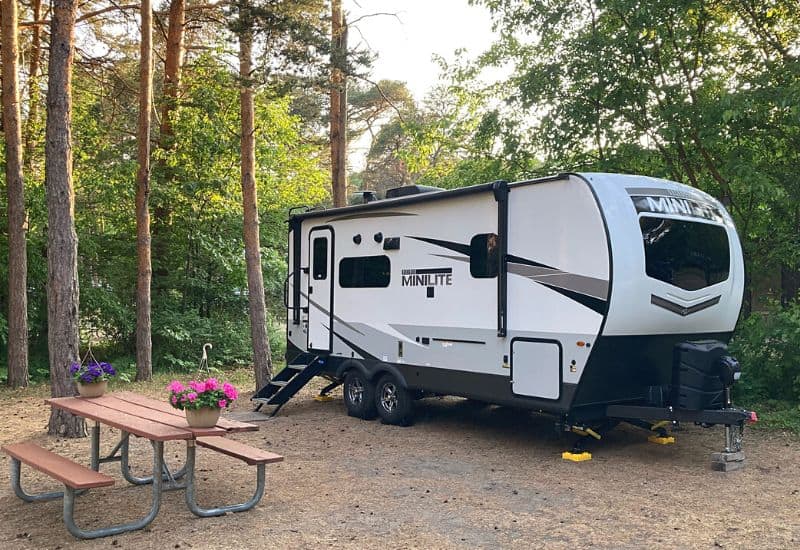If you’re new to RVing, seeking out tips and tricks can make RV life easier, allowing you to learn from the mistakes of others.
The issue, however, is that most beginner RV tip lists focus on relatively obvious things that new RVers can quickly figure out on their own.
So, for this list, we consulted seasoned RVers and delved deep into our own experiences to compile these less obvious tips that RVers often have to learn the hard way over a lifetime of RVing.
1. Don’t Buy a Bunch of RV Accessories Before You’ve Made a Few Trips in Your RV
While it might be tempting to run out and buy a bunch of RV accessories and gadgets for your RV because you’re excited about the new RV and RV life.
It’s best to avoid most of these initial impulse purchases in the beginning, until you’ve owned your RV for a while and know what you really need.
This will save you a bunch of money in the beginning and keep you from filling your RV with a bunch of stuff you won’t use and didn’t need in the first place.
In fact, you might be surprised to learn that enjoying RVing often requires just a handful of items beyond the RV itself.
Basic RV Gear First Time RVers Actually Need
- Wheel Chocks
- Leveling Blocks
- RV Water Hose
- RV Sewer Hose
- Surge Protector 30 Amp or 50 Amp (Depending on Your RV)
2. Travel Slower: Don’t Try and Do it All in One Trip
Probably the biggest mistake most first-time RVers make is trying to cram too many destinations and activities into a single trip.
And while I can understand why this happens, as new RVers want to try and experience as many things as they can in the few short weeks they have a year for vacation.
What often happens is everything just kind of goes by in a blur and the RV trip starts to look more like a to-do list that needs to be completed instead of a trip that should be enjoyed.
Instead, a much better way to RV is to travel slower, allowing you and your family enough time to really experience and enjoy each place you visit.
So for example instead of trying to cram Yellowstone National Park into a two-day trip, maybe spend a week there or more, so that you can really experience everything the park has to offer.
Also, don’t forget to schedule downtime into your RV trip as well, to just relax and unwind, so you don’t feel like you need another vacation just to recover from the RV vacation you were just on.
3. Don’t Leave Your Awning Out When Your Not Under It
While RV awnings greatly extend your RV’s living space, they can also become expensive and costly to repair if damaged, with wind being the number one cause of damage.
This is because an awning acts like a big sail on the side of your RV and one strong wind gust can bend the awning frame or arms or even completely rip it from its mounting brackets.
Which can cause all kinds of issues including damage to the fiberglass body of the RV, which can be very expensive to repair.
So to prevent all these issues, the best thing you can do is to retract your RV awning whenever you’re not under it or at a bare minimum at least when you leave your campsite.
Also, if you’re thinking I don’t need to worry about this because my RV has an awning wind sensor where the RV will retract the awning automatically if it senses wind.
It’s still best to retract your awning when you’re not under it, as these wind sensors are not foolproof and can malfunction.
4. Make Sure You Have a Spare Tire for Your Travel Trailer
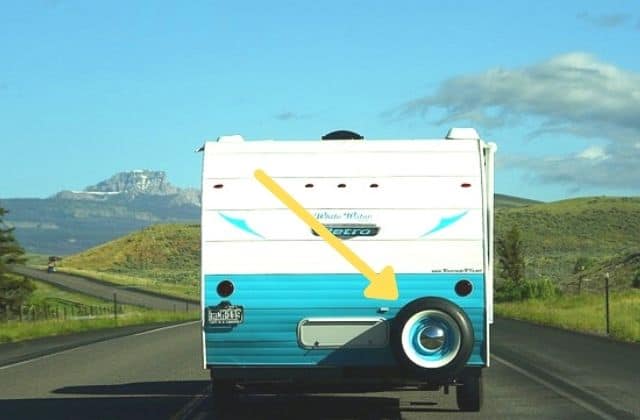
You might assume your travel trailer has a spare tire in or under it, but you’d be surprised at how many new trailers come without one.
And the last place you want to discover that your travel trailer lacks a spare tire is when you’re stranded on the roadside with a flat tire.
So, make sure to check if your travel trailer is equipped with a spare tire, and if it isn’t, invest in buying one for your trailer.
So if you do happen to get a flat tire in the middle of nowhere, you will have the spare you need to keep on rolling down the road.
5. Always Shut Your Water Off When You Leave Your Campsite
While it might seem like a nuisance to shut your water off every time you leave your campsite.
This one simple task can save you a lot of hassle and potentially costly repairs if something were to go wrong with your plumbing while you are away.
Because the fact of the matter is plumbing fixtures, pipes, and connections can and do fail all the time.
And while it might not be a big deal if you’re in or around your campsite and can catch the leak early.
If a plumbing issue occurs while you’re away for the day and no one is there, it can create a huge mess and potentially cause thousands of dollars in damage to cabinets and flooring.
So, before you leave the campsite, especially for the entire day, turn off the water to the trailer. You can usually do this by turning just one valve where the water enters the trailer.
6. Check the Air Pressure in Your Tires and Torque on Your Lugs Before Traveling
Before taking any major trip in your RV, you should always check the tire pressure in your tires and the torque on the lugs of your wheels, especially if your trailer has been in storage or sitting for a while.
This is important because you want to make sure that your tires are always at the recommended tire pressure per the manufacturer’s recommendations.
As this will go a long way in improving gas mileage as well as reducing the likelihood of a tire blowout while driving.
But don’t just stop at checking the tire pressure, as you should also check the torque on your lugs to ensure they are nice and tight.
And the best way to do this is by using a torque wrench like this popular one on Amazon.
Torque wrenches are great because they let you torque the lugs down on your wheels to the exact specification of the manufacturer, which you should be able to find in your RV owner’s manual or by asking your local RV dealer.
7. When Backing Up Make Sure to Look Up for Tree Limbs
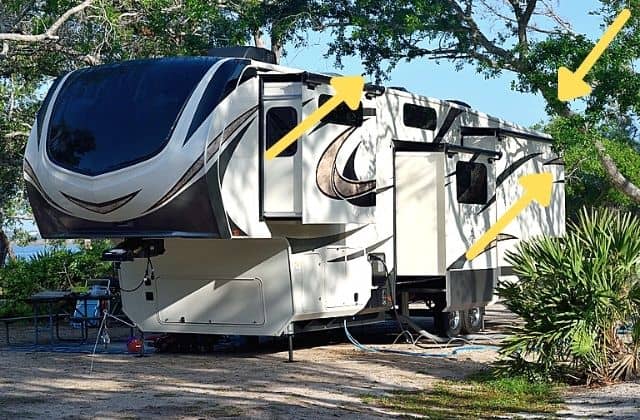
Often times when backing an RV into a campsite, we are looking for obstructions on the ground or at eye level but forget to look up for potential obstructions such as tree limbs or branches.
So it’s important to remember that most RVs are usually 10 feet or taller and it can be very easy to run out of clearance towards the top of the trailer especially if the campsite is heavily wooded.
In fact, this is one of the most common ways RV rubber roofs are damaged because it doesn’t take a very big branch or tree limb to puncture or tear an RV rubber roof.
8. Change the Smoke and Carbon Monoxide Detector Batteries After Storage
Something most RVers don’t think about is the batteries in their smoke detector and carbon monoxide detector because they rely on the beep of the device to tell them when it’s time to change the batteries.
The problem with this approach, however, is that RVs are often stored for long periods of time.
And the device’s tell-tale beep indicating a low battery might have been sounding for months while the RV was in storage, until the battery drained so much that it no longer beeped.
So when you take your RV out of storage for the new camping season, you think everything is fine but in actuality, you potentially have a completely dead smoke detector or carbon monoxide detector.
So when you take your RV out of storage for the camping season, be sure to replace the batteries in the smoke and carbon monoxide detector or at least press the test button to make sure they are both still operational.
9. Carbon Monoxide or CO2 Detectors Are Only Good for 5 Years
A fact that usually surprises most RV owners is that carbon monoxide or CO2 detectors are actually only good for 5 to 10 years, as the sensor that reacts with carbon monoxide becomes less sensitive over time.
So while that 7-year-old CO2 detector in your RV could be functioning fine, as it’s within the 5 to 10 year average life expectancy of a carbon monoxide detector.
In my opinion, it’s just not worth the risk to keep using a 7-year-old detector, as it also might not be working properly potentially putting you or your family in danger.
So if you own an RV that is older than five years, it’s a good idea to replace the carbon monoxide detector in the RV with a new one to provide the maximum amount of protection for you and your family.
And if you’re looking for a good replacement carbon monoxide detector, check out this popular one on Amazon by Kidde with over 15,000 reviews by clicking here.
10. Empty Your Black Tank First Then Your Grey Tank
While this might seem like a fairly obvious one to some, oftentimes new RVers don’t always get the best walkthrough of all the RV systems from their RV dealer.
So it’s worth mentioning for beginning RVers, that you always want to empty your black tank first then your gray tank, as the gray tank will help to flush out your sewer hose from the black tank dump.
11. Check Your Fluid Levels in Wet Cell Batteries Regularly
Wet cell batteries which are also known as lead-acid batteries are the most common type of RV battery, as they are reliable, time-tested, and cheap compared to more expensive RV batteries such as lithium batteries.
And if you have a wet cell battery in your RV, it’s a good idea to check the water level of the battery periodically to make sure the water level is where it should be for optimal battery performance.
If you’re unfamiliar with how to do this, just check out this super helpful YouTube video that provides a complete walkthrough on how to check the water level of the RV battery as well as how to fill the battery with distilled water if it’s low.
12. Plan Your Drive and Drive Your Plan
We all need a little spontaneity in our lives.
A place where it’s usually best to avoid a lot of impulse decisions though is when you’re planning or on an RV trip.
As a well-laid plan is one of the best ways to avoid unwanted surprises and ensure maximum enjoyment for you and your family while on your RV vacation.
And while it’s okay to interject a little spontaneity into your RV trip from time to time.
Once you’ve made your RV trip plan, try to stick to it as much as possible to help make sure the trip goes as smoothly as possible, which will help to reduce your stress and anxiety levels.
13. If Something Goes Wrong it’s Not the End of the World
Spoiler alert, if you have an RV and do a lot of RV travel, it’s not a question of if, but a question of when something will go wrong.
It’s important early on in your RVing journey to learn to roll with the punches and learn that when something goes wrong it’s not the end of the world and is just part of the journey.
So if something breaks, which it will, or something doesn’t go to plan, which it won’t.
Just remember to take a deep breath and remember that whatever breaks can be repaired and whatever didn’t go right can be adjusted for.
And that these little bumps in the road are often what we remember the most and look back on fondly when recalling a particular RV trip.
14. Check the Caulking and Rubber Roof Once a Quarter
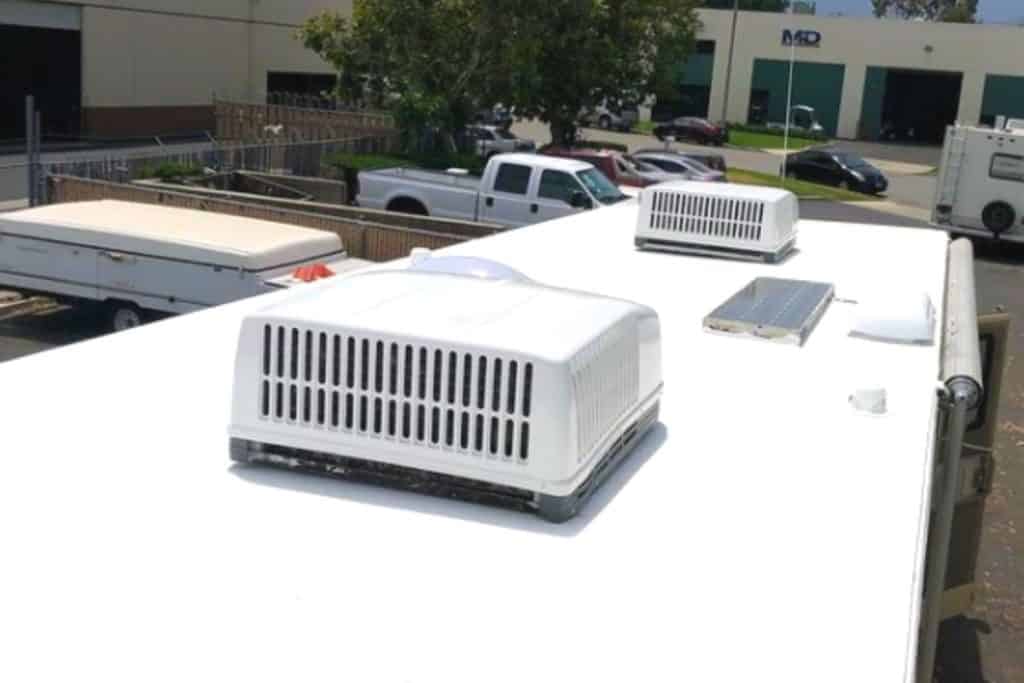
No matter what type of RV you have, it’s important to periodically inspect and walk the RV roof. (If the RV roof is walkable, which most are.)
The reason why this is so important is that the number one cause of RV damage is water damage.
And the most likely source of this water damage is the RV roof.
This is because most RV roofs with the exception of a few brands like Airstream which has an all-aluminum body and Scamp which has an all-fiberglass body will have a rubber roof that can easily be damaged.
So it’s important to inspect the RV rubber roof once a quarter, if not more frequently, to ensure there are no punctures or tears in the rubber roof that could have compromised the roof or caused a leak.
But you don’t want to just inspect the rubber roof, as you also want to inspect the caulking around all vents, pipes, and seams to ensure they all have a good bead of silicone or caulking around them, with no gaps or cracks.
If you want to learn more about your RV’s rubber roof and the best ways to care for it, be sure to check out our helpful blog post titled “Why Do RVs Have Rubber Roofs“.
15. Check for Obstructions Inside and Outside Before Opening and Closing the Slides
There is perhaps no more terrible of a sound than a grinding or dragging sound when you’re opening or closing the slides on your RV.
So before you open or close your RV slides, be sure to check for obstacles or obstructions both on the exterior as well as on the interior of the RV.
Some of the more common obstructions to check for before opening or closing your slides are:
- Exterior tree limbs or branches near the slide could get in the way when opening the slide.
- Fallen debris on top of the slide that has been collected while you were camping could cause issues when closing the slide.
- Potential items that could have become lodged in or around the slide, especially under the carpet of the slide could drag across the floor when the slide is brought in.
16. Understand Off Tracking and Watch for Tail Swing When Turning
Most of us before we bought our first RV, were used to driving vehicles that were 20 feet or less, with a very short wheelbase, with little to no rear overhang.
So it can be a real adjustment when trying to learn how to drive a 30 or 40-foot motorhome or truck and trailer combo that has a very long wheelbase and a lot of rear overhang.
Especially when it comes to turning these larger rigs or motorhomes.
And when it comes to turning your RV the two most important things you need to be aware of are off-tracking and tail swing.
Off-Tracking
Off-tracking is where the front wheels of the RV turn on a different radius when compared to the drive axle or rear wheels of the RV.
And the longer the wheelbase your RV has the more pronounced the off-tracking will be, which is where many new RV drivers get into trouble.
Because new RV drivers don’t account for the off-tracking or different turning radiuses of the front and rear wheels of the RV.
Often turning the front wheels of the RV too early in a turn, which doesn’t allow enough clearance for the rear wheels of the RV to make the turn without running into an obstruction at the pivot point or rear wheels of the RV.
Tail Swing
Most RVs have a considerable rear overhang beyond the rear axle of the RV, which can create a real issue of tail swing, especially when making tight turns.
As the rear overhang of the RV will swing out in the opposite direction from the way you’re turning potentially hitting an object that might be near the RV.
So it’s very important to be mindful of your surroundings as well as your tail swing when navigating your RV in tight spaces.
17. Chock Your Wheels After Leveling and Before Disconnecting
Even if the ground or campsite you’re parked on seems level.
Always chock your trailer wheels after you’ve leveled the RV and before you disconnect it from your tow vehicle.
As even just a few degrees of slope can cause an RV to roll or shift from its original position even if the leveling jacks are down, which can be very dangerous.
18. When Buying an RV Don’t Overspend and Buy the Smallest RV That Will Fit Your Needs
Often when RV beginners are looking to buy their first RV, they will overspend and buy an RV far larger than they actually need.
Which can leave the new RVer cash strapped and with an enormous RV that is hard to navigate and fit into smaller campsites, limiting the number of places they can take the RV and camp.
So remember when shopping for RVs, that the RV is a means to an end which is traveling and living the RV lifestyle and not the end goal itself.
19. Make Sure Your Glass Shower Door Is Latched Before Leaving
While this one might seem kind of trivial, it’s actually very important to remember to latch your glass shower door before travel.
As these glass doors can easily shatter or break during travel if not properly secured.
And if they do break this can often be a very expensive repair, because the glass door usually has to be custom-made to fit the particular shower stall dimensions of our RV.
20. Remove the Glass Plate in the Microwave Before Traveling
Another one that might seem kind of trivial, is remembering to secure or safely store the rotating glass plate inside the microwave before traveling.
However, if you’ve ever tried finding and replacing a broken microwave glass plate before you know what a nightmare this can be, as each microwave and manufacturer uses a slightly different glass plate in their design.
Often requiring you to special order the plate directly from the manufacturer if it breaks, which might not even be possible depending on how old your RV and microwave are.
21. Keep an RV Journal
Keeping a journal for your RV adventures is more than just a way to preserve memories – it’s a practical tool that can enhance your RVing experience in multiple ways.
If you’re not sure what to put in your journal here are some of my personal favorites.
What to Keep in Your RV Journal
- Trip Documentation: Your RV journal can serve as a chronicle of your travels. Record the dates, locations, and duration of your trips. Include details like the weather conditions, scenic spots, and even those little off-the-beaten-path discoveries. It’s not just about where you went, but the experiences you had along the way.
- Campsite Details: Jot down specifics about the campsites you visit. Note the site number, the amenities available, the quality of the site (like shade and levelness), and any nearby attractions. This information is invaluable for future visits and can also be shared with fellow RVers.
- Maintenance Logs: Keep track of any maintenance or repairs you perform on your RV. Note the date, what was done, and perhaps even where you purchased parts or received service. This log is incredibly helpful for keeping your RV in tip-top shape and can also be useful for warranty purposes or if you decide to sell your RV.
- Budget Tracking: Use your journal to track expenses related to your RV trips. This includes campsite fees, fuel costs, maintenance expenses, and any other costs incurred. It’s a great way to manage your budget and plan for future trips.
- Neighbor Notes: Often in your travels, you’ll meet fellow RVers who can share tips, routes, and must-visit locations. Record the names and contact information of these new friends, along with any recommendations they have. It’s like building your own personal RV community.
- Personal Reflections: Finally, don’t forget the personal aspect. Write about your feelings, the sights that took your breath away, the quiet moments of sunrise or the fun evenings by the campfire. These personal reflections turn your journal into a cherished keepsake that captures the essence of RV living.
22. Invest in a Good GPS Designed for RVs
When you’re on the road in your RV, having a reliable GPS designed specifically for RVs can be a game-changer.
These GPS systems are more than just your average direction-giving devices; they’re like a trusted co-pilot tailored for RV travel.
As they provide routes that are specifically suitable for your RV’s size and weight.
This means you’ll be steered clear of those low bridges, narrow lanes, and roads with weight restrictions that can turn a leisurely drive into a stressful ordeal.
Then there’s the matter of specialized alerts.
An RV GPS doesn’t just tell you where to turn; it warns you about sharp curves ahead, alerts you to steep inclines, and can even provide real-time traffic and weather updates.
One of the best things about an RV GPS though is its in-built database of campgrounds and RV parks.
Imagine having a comprehensive guide to potential stopovers right at your fingertips, especially handy when you’re venturing into unfamiliar territory.
If you’re looking for a RV GPS recommendation, one of my personal favorites is the Garmin RV 795 GPS Navigator, available on Amazon.
23. Regularly Exercise Your Generator
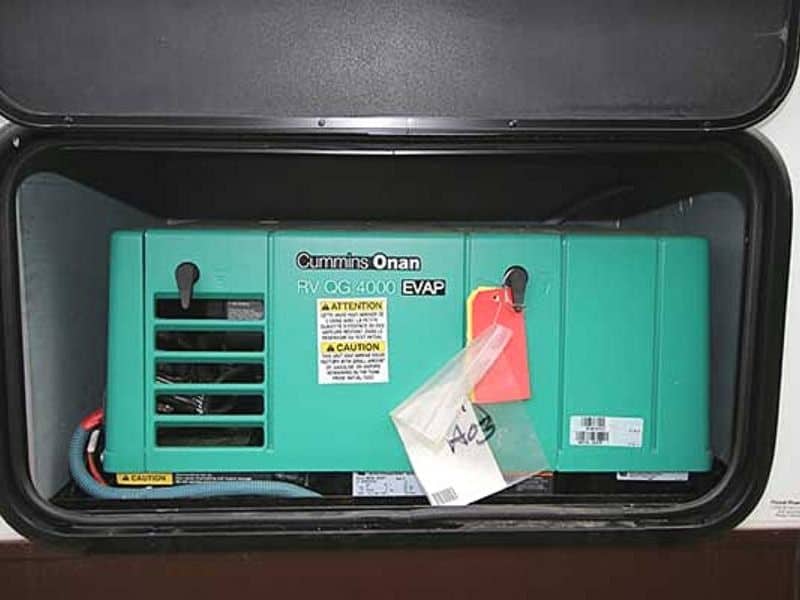
Maintaining the generator in your RV is just as important as taking care of the engine that drives you down the road.
Regularly exercising your generator plays a crucial role in ensuring its reliability and longevity.
It’s not just about running it when you’re out on a trip; it’s about keeping it in prime condition all year round.
When you run your generator regularly, you’re essentially keeping all its components in motion and well-lubricated.
This is important because, over time, the internal parts of a generator can seize up or deteriorate if not used.
Another aspect to consider is the fuel. Running the generator helps in using up the fuel before it goes stale, which is especially important if you’re not using your RV frequently.
Stale fuel can lead to a host of problems, from clogged fuel lines to difficulty in starting the generator.
The rule of thumb is to run your RV generator for about an hour each month, ideally under load. This means turning on a few appliances inside the RV to ensure the generator is doing some work.
This practice ensures that when you really need your RV generator – whether it’s for powering your AC on a hot day or keeping your fridge running during a stopover – it won’t let you down.
24. Know Your RV’s Height and Width
It’s crucial to know your RV’s exact height and width. Write it down and keep it handy in the driver’s area.
The height of your RV is particularly crucial.
Many new RVers learn the hard way that not all bridges or overpasses are made the same.
There’s nothing more heart-stopping than approaching an overpass and not being sure if you can fit under it.
Low clearance bridges can cause significant damage to your RV if not navigated correctly. This is where knowing your RV’s height – and keeping this information readily accessible in the driver’s area – becomes invaluable.
It’s a simple step that can save you from costly and dangerous mistakes.
But it’s not just about height. The width of your RV also plays a big role, especially when navigating through tight spots like narrow roadways, campsite entrances, or even toll booths.
Knowing your width helps you understand how much space you need to maneuver, ensuring you don’t scrape or bump into obstacles.
25. Pack a Basic Tool Kit
Always have a basic tool kit on hand. It’s essential for dealing with those unexpected minor repairs that are part of RV life.
The open road can be unpredictable, and a well-equipped tool kit can be the difference between a quick fix and a trip-derailing problem.
A screwdriver set is a must-have in your RV tool kit. You’d be surprised at how often screws can loosen from the constant vibration of travel.
Don’t forget a good set of pliers. From gripping to twisting, they’re invaluable for various tasks, whether it’s a plumbing fix or adjusting a loose connection. Similarly, an adjustable wrench set is crucial for dealing with nuts and bolts of different sizes. It’s handy for tasks ranging from tightening bike racks to fixing a loose battery connection.
Duct tape is another hero of the RV world. Its versatility is legendary – from temporarily fixing a broken hose to patching up a tear in your vinyl seat, duct tape can provide a quick solution until a more permanent fix can be made.
Lastly, it’s wise to include some basic electrical tools and supplies, like wire cutters and electrical tape. Electrical issues are not uncommon in RVs, and being able to perform a simple fix can be a lifesaver.
For a list of must-have RV accessories, every RVer needs to have, check out our article “20 Must Have RV Accessories Under $20“.
Recent Posts
When cruising down the highway in your RV, the last thing you want is a tire blowout! Not only is it dangerous, but RV tire replacement isn't cheap, costing $200 to $300 per tire. The good news,...
Nothing ruins an RV adventure faster than a breakdown with no way to fix it. Because of this, every RVer should have a well-stocked RV tool kit for those unexpected roadside emergencies and campsite...
